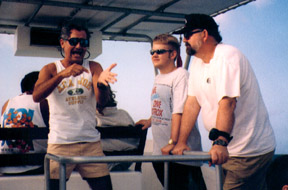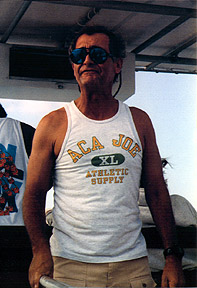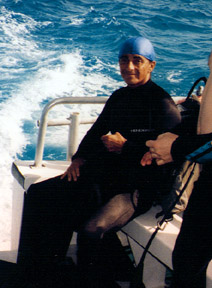| |
|
- You need to be weighted properly. Shed your excess lead. Propelling an overweighted diver through the water is work. Less work = better air consumption. As you work on breathing patterns, you'll be able to take off even more weight.
- Be sure that you really have mastered buoyancy control. Taking extra breaths to keep from crashing on the bottom, or blowing air out to keep from ascending wastes air. Diving should be graceful - like an underwater ballet. Even a big ol' jewfish knows this.
- Avoid blowing off lots of air on descent. There's a tendency to do this when clearing ears.
- Stay warm underwater. Even in 78 deg F water of Cozumel, Ricardo and his crew dive with full wetsuits over skins, and with hoods. Heat loss from the head (or other body parts) means greater air consumption.
- Stay physically fit on land. Ricardo runs to the boat each and every morning, arriving drenched in sweat. On the way to the dive site, he does extensive stretching and relaxation exercises. A person who is cardiovascularly fit uses less air both at rest and with exercise. If you're sedentary now, consult with your physician before beginning an aerobic exercise program.
- Use only your legs for underwater propulsion, and get an instructor to critique your various finning techniques. The Careyitos crew swear by their big H. Dessault Radical fins, but form is also important. Swimming with the hands is useful only in shipwrecks and caverns, where you don't want to silt up the bottom.
- Stay relaxed underwater. Some divers use meditation techniques for this.
- All NASDS divers are taught how to calculate Surface Air Consumption (SAC) in the basic Open Water course. This should be logged for every dive, not only for use in dive planning, but also to track your progress in lowering air consumption.
That being said, let's get down and dirty. The basic goal is to breathe less often without becoming uncomfortable and without violating the first rule of SCUBA - Always Breathe Continuously. Most of the techniques below are intended to prolong your inspiration.
Assess your surface breathing, something you normally take for granted. Most guys and many women breathe by expanding and contracting the chest wall. For SCUBA, Tony recommends diaphragmatic breathing. Put one hand on your chest over your heart, and another on your stomach over your belly button. Now, watch yourself breathe. If your upper hand moves in and out, you're a chest wall breather. Keep breathing, but instead make your lower hand move in and out while keeping the upper hand motionless. This is how trained singers breathe.
Ricardo uses complex mental imagery for diaphragmatic breath control. At the beginning of a breath, he imagines a bubble forming in the upper chest, growing slowly to occupy the upper chest, the middle chest, the lower chest, and then the abdomen.
Now, let's talk about the difference between "not breathing" and "holding your breath". In holding your breath, air goes in and you willfully close your throat to keep it in. Maybe you make a gasping noise when you finally release the trapped air. What actually happens is that the vocal cords come together and close off your airway. In SCUBA, this is dangerous. Remember Boyle's law. If you ascend (even just a little bit) while holding your breath you run the risk of pulmonary barotrauma (pneumothorax, pneumomediastinum) and air embolism. "Not breathing" is a different concept. Air is neither going in nor out, but your throat is open, and if you ascend, expanding air in your chest will come out. This is what you did in practicing emergency buoyant ascents from depth. You should not practice any of the breathing patterns described below until you completely understand the difference between these concepts.
Next, a word about "skip breathing". If you pause too long between breaths, carbon dioxide will build up in your blood and stimulate the breathing center in your brain. You will feel short of breath and start breathing heavily. If you blow off too much carbon dioxide you will feel even more short of breath and hyperventilate. This can cause a feeling of anxiety as well as trigger headaches. If reading this makes you hyperventilate, you can take a few breaths in and out of a paper bag in order to bring your carbon dioxide level back to normal. That method doesn't work underwater, so "skip breathing" should be avoided. Any of the methods below, taken to extreme, will result in "skip breathing", so go slow.

Tony's Underwater Breathing Patterns
- Count to yourself as you breathe in and out. At first, work towards a slow "5" in and a slow "5" out, making sure that breathing is continuous and not interrupted. Don't forget about diaphragmatic breathing. As this becomes comfortable, increase the length of inhalation while maintaining the slow continuous "5" out. Increase one count at a time, as you become more comfortable. If you feel air hungry, drop back down to a count that feels better. If you'd like meditate on the bubble growing in your chest. Keep your exhalation count a constant "5" as you increase (with time and practice) to an inhalation count of 15 or even 30. As you get better at this, you will probably have to put air in your BCD to maintain neutral buoyancy. Eventually, you will take weight off your belt. Some divers put their tongue up against their teeth to slow down the inhalation. Others imagine taking a long continuous "sip" of air through a narrow straw.
- Take about a third of a full breath in, stop breathing (but DO NOT hold your breath), count to 5, take in another third, stop breathing for a 5 count, take in the last third, stop breathing. Then exhale continuously for a 5 count. As this becomes more comfortable, increase the count while not breathing, maybe to as much as 15. With practice, you might be able to take a fourth or less of you air in with each "sip".
- Take about 2/3 of you air in, stop breathing for a 10 count, take the rest of the air in, and then exhale continuously for a 5 count.
- Take a quick, short full breath all the way in, and exhale continuously for a 10 count. As the pattern becomes more comfortable, increase the count on exhalation. This pattern will make you more positively buoyant (in other words, make you go up). It is useful if you ever need to haul up a distressed diver who is overweighted (and for some reason you can't ditch the weight belt).
- Ricardo's "default" breathing pattern is far more complicated, and while it works well for him, it is not recommended for us "ordinary" divers. He weights himself so that he is slightly "positive" in the water. He takes about an eighth of his breath in, stops breathing for a count of 7 or so, takes another eighth in, counts 7, etc. Then he exhales continuously for a 5 count. After years of practicing this, this extraordinarily physically fit gentleman, who dives nearly every day, exhales about once a minute. As he becomes more positively buoyant, he assumes a head-down position in the water and gently kicks down to keep from ascending. He levels off and then exhales.

Each of these is different, but each will result in slower underwater breathing. They can be practiced on land, and I've tried doing so while riding a bicycle. Don't practice them to the point that you are in any way uncomfortable or short of breath! Tony made the point that with practice they become second nature, and just happen automatically. In a dive, you should switch patterns from time to time (saving pattern #4 for special situations) not only for variety, but also in case one doesn't feel right at the moment. There's a lot of potential for adding some Zen, Yoga or Transcendental Meditation into all this, I guess.
I can assure you that this works. Although I still have my beloved HP120's, I usually come up with 1000-1500 PSI left - and did the 2001 Roatan trip on AL80's.
Now for some other ideas that didn't come from Ricardo or Tony (Nerk-nerk!)
- Get narced. You don't need no stinkin' tank!
- Ask your doctor for some Pavulon or succinylcholine. These medications will markedly reduce your air consumption. Back on the boat with 3000 PSI every time!
- Get a gill transplant.
- Have the air fill station put just a little hydrogen sulfide in your tank. That will make every breath an absolutely necessary one.
- Fix your air gauge so that it stays stuck at 2500 psi.
- If you have an air-integrated dive computer, rig up an interface that gives you a slight electric shock any time you breathe more often than once a minute.
Dive long, and prosper. And dive safe.
|


